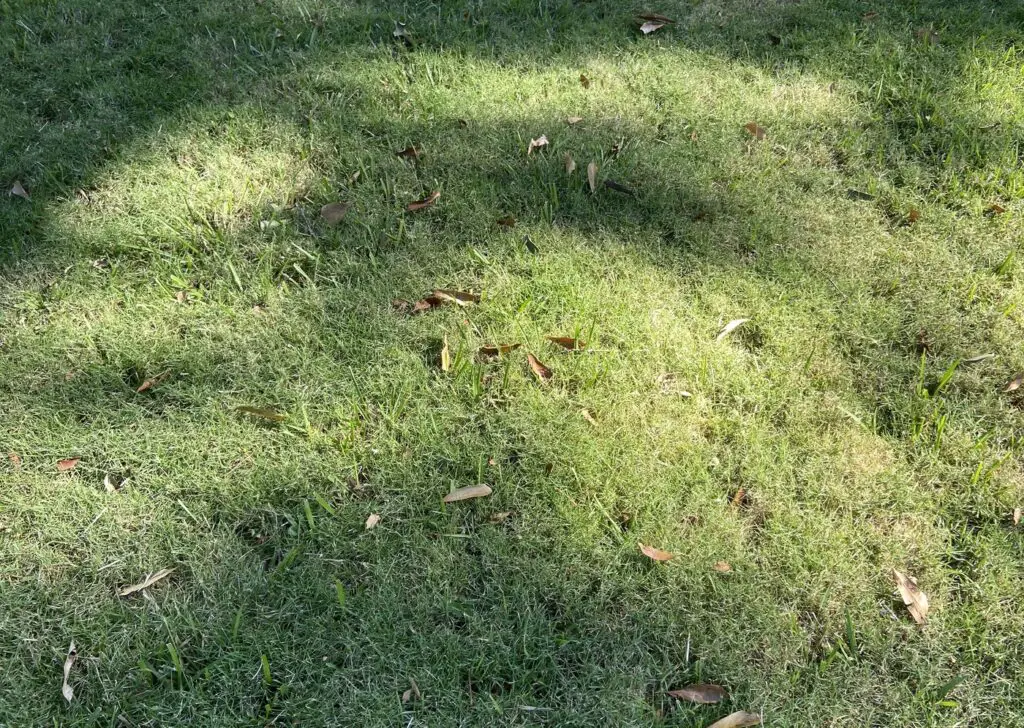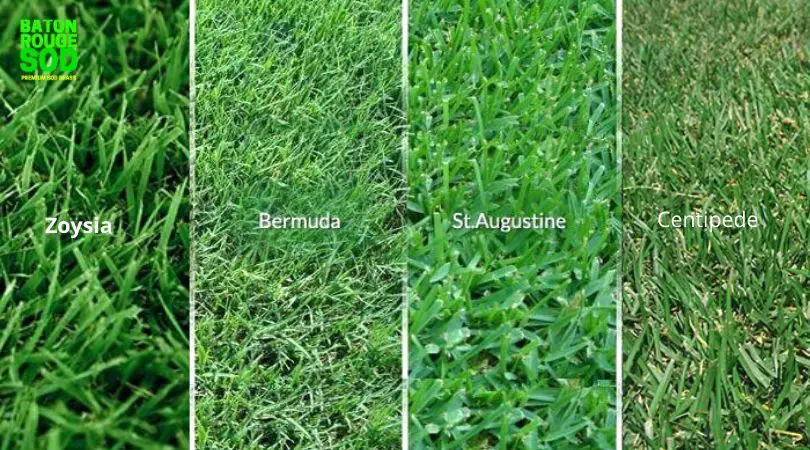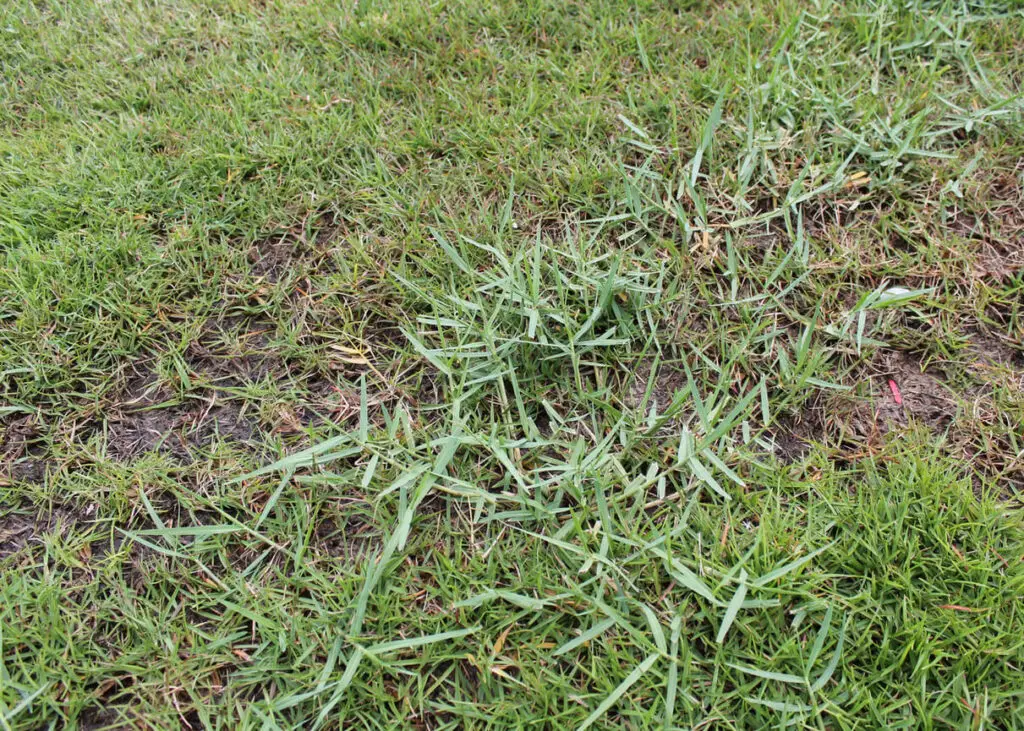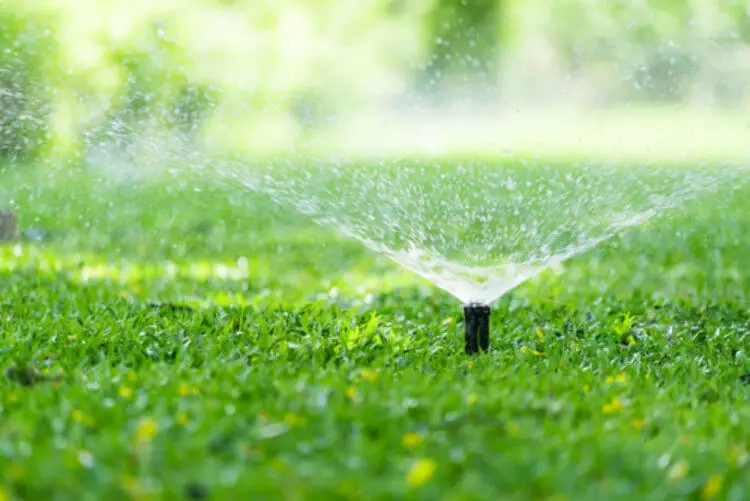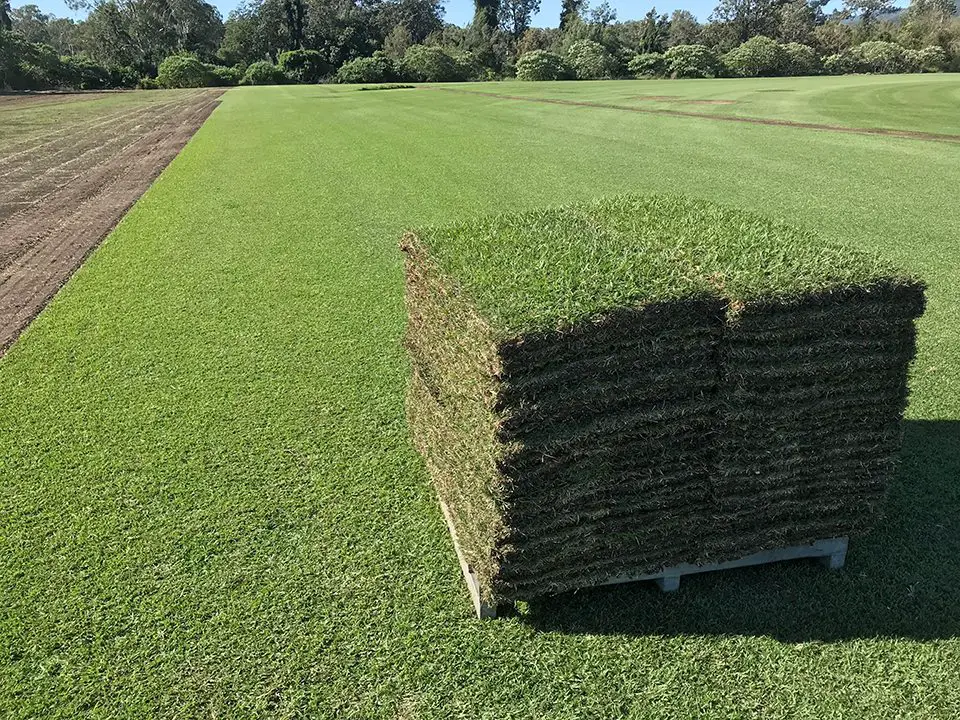Characteristics explaining what bermuda grass looks like..
I’m often asked what does bermuda grass look like?
When I describe its looks to people I start with the most distinguishing characteristics.
Bermudagrass is a low growing turfgrass, with thin narrow leaf blades, and color ranging from bright green, to medium, to dark green color.
It’s visually identified by its fine-textured leaf blades that are typically around 1/8″ wide (2-4mm wide) and a low to the ground growth habit.
Bermuda also has a distinctive V-shaped leaf blade and pointed tips, which helps distinguish it from other types of turfgrass.
What Is Bermuda Grass?
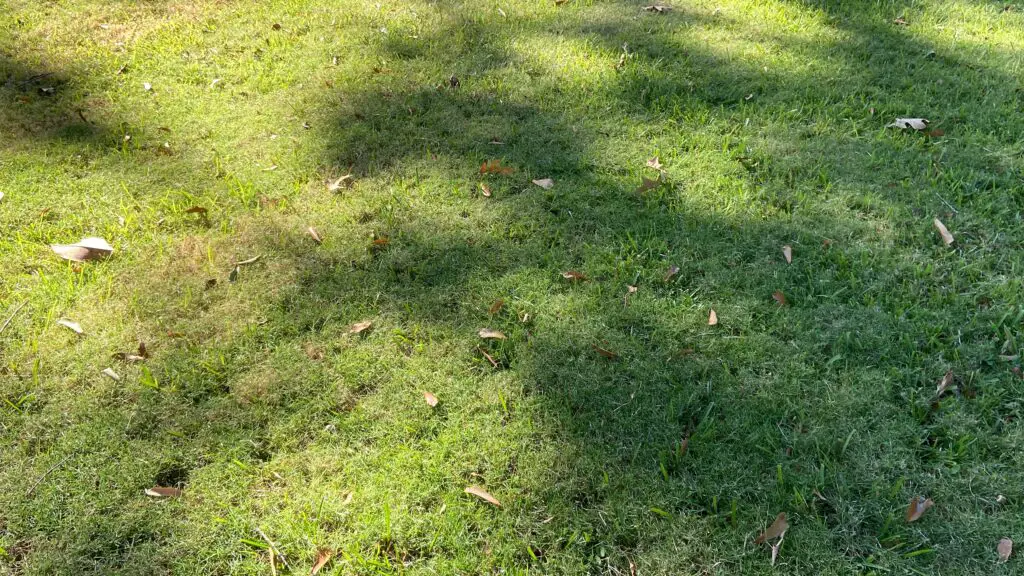
Bermuda (Cynodon dactylon) grass is a warm-season turfgrass that originated in Africa, and spread to the Middle East and Asia.
Today, Bermudagrass is found all over the world in residential and commercial lawns.
Bermuda is one of the top selling turfgrasses due to its fine texture, deep green tone, great resistance to heat and drought, and foot traffic tolerance.
Rapid establishment and quick growing rate are among its most distinguishing features.
When exposed to sunshine and a sufficient water supply, it may grow up to two inches each week throughout the summer months.
Overall, Bermuda is a very popular turf, with massive distribution worldwide; and is the highest selling sod and seed cultivar varieties.
What makes Bermuda so special?
The main feature of this turfgrass is is toughness and durability.
It is an excellent choice for high traffic areas due to its ability to handle heavy foot traffic with minimal damage.
These characteristics make it a popular sought after lawn options, especially across the southern United States.
Bermuda grass identification

How Do You Know If You Have Bermuda Grass?
The key characteristics of Bermudagrass is its leaf blade shape and texture, measuring an approximate width of 1/8″ wide (2-4mm wide) by 1″ – 1 1/4″ long (10-30 mm) long with pointed tips that are slightly flattened at their bases.
A simple description is a thin grass that grows short and low to the ground.
Correct identification is of Bermudagrass is essential to understand the growth habits.
Bermuda is considered a weed by some because of its ability to spread quickly through stolons and rhizomes.
This is especially important, since it tends to take control over other varieties and make its removal an uphill struggle.
However, it is still desirable for multiple applications due to its durability and resilience.
The two main categories of Bermudagrass are common Bermuda grass and hybrid Bermuda.
They are both from the same grass species, within the species are multiple types of bermuda grass lawn.
Once established, however, its effects on other parts of your garden could prove devastating unless dealt with promptly and successfully.
What Does Bermuda Grass Look Like?
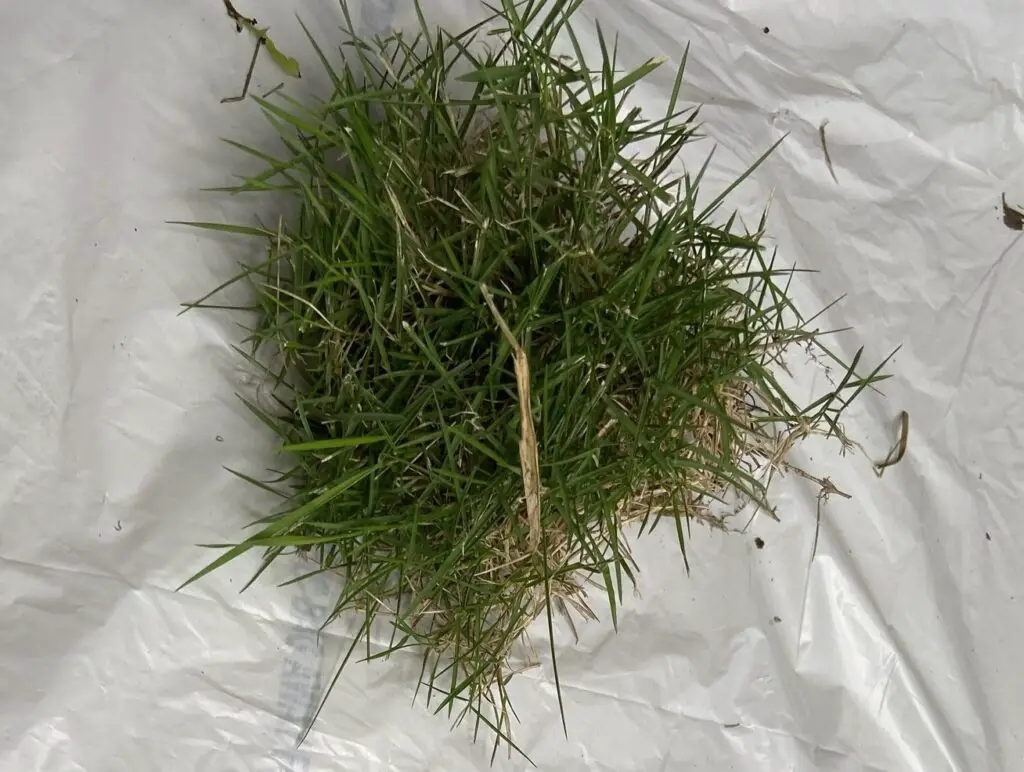
Bermuda can easily be recognized by its fine, smooth leaf blades and its vibrant green hue.
Thin V-shaped leaf blades with pointed tips distinguish this turfgrass variety from others.
These plants boast dense growth habits with abundant runners that form lateral roots that enable it to tolerate heavy foot traffic areas.
If you are uncertain whether you have a Bermuda lawn, an easy way to tell is by inspecting its stem’s base for signs that its leaves bear teeth-like protrusions that look similar to shark fins.
These key characteristics will allow you to easily recognize this widely utilized turfgrass species.
Here are the physical characteristics that help identify Bermuda grass:
1. Narrow and Long Leaf Blades:
Bermuda grass features short, narrow leaves measuring from 2-4mm wide by 10-30 mm long.
2. Sharp-Pointed Tips:
The tips of Bermuda grass leaves have sharp points with flat leaves that resemble a knife blade.
3. Rolling Inflorescences:
These flowering structures and seed heads feature distinctively distinguishable inflorescences that make them easier to identify.
4. Stolons or runners:
Turfgrass propagates itself via lateral expansion through its roots, nodes, and rhizome.
Fast-growing runners root to the ground while simultaneously growing out into new plants that propagate in the area.
These runners give it its characteristic creeping growth pattern.
5. Pale green to Emerald coloration:
Color is another key indicator of cultivar variety, and type; along with the amount of nutrients available.
During summer months, its tones range from pale green to deep emerald while during fall when temperatures decline significantly due to increasing maintenance measures it takes on an amber tint requiring extra care for proper upkeep.
How to Identify Bermuda Grass

Here are some key traits that make Bermuda grass identifiable:
Leaf blades
Bermuda grass has slender, pointed leaf blades that are flattened at the base.
Growth pattern
Bermudagrass typically grows in a short, dense manner; and expands by stolons or runners.
Texture
Bermuda-grass leaves exhibit fine thin texture that feels soft and thin underfoot when compared to other turf grasses.
Coloration
During peak growth seasons, Bermuda-grass displays vivid green to dark green coloration depending on the amount of fertilization.
It then transitions into shades of yellow-brown before dormancy over winter period.
Tolerance of hot temperatures
It’s known for it’s high tolerance levels to droughts, above-average heat stress tolerance, and rapid growth recovery times.
Inflorescences (seedheads)
The seedheads have uniquely spiked and rolling shapes which are usually brown from spring through fall season; with noticeable bending behavior when approaching maturity.
What is Hybrid Bermuda Grass?

Hybrid Bermuda grass is a type of grass that is created by crossbreeding two or more different types of Bermuda grass.
The resulting grass is a hybrid that has traits of both parent varieties.
These hybrids are often crossbred for desirable traits, such as improved texture, color, and density, and they are known for their high quality and resilience.
Hybrid Bermuda grass is highly valued for its superior quality and performance, and it is commonly used for sports fields, golf courses, and high-end residential lawns.
Most cultivars were developed through a process called hybridization, which involves crossbreeding two different types of Bermuda grass to create a new variety.
The process is done by selecting the best traits from each parent variety and combining them to create a new and improved grass.
The resulting hybrid grass has improved characteristics such as disease resistance, drought tolerance, and/or better overall performance.
There are numerous hybrid bermuda grass varieties. Hybrid varieties differ from common lawn grass.
Most of the varieties are a considerable improvement from traditional bermuda grass, offering more dense-foliage, higher disease resistance, as well as drought tolerance.
Hybrid Bermuda-grass has higher tolerance levels for heavy foot traffic which makes it ideal for high-traffic areas like sports fields and golf courses.
Overall hybrid Bermunda grass provides denser foliage structure compared with regular species leading to superior resistance against infestations by unwanted weeds and pests commonly affecting local lawns attributes that easily distinguish them from standard Bemauda strains.
Some common and popular varieties of hybrid Bermudagrass
- Tifway 419
- Celebration
- TifTuf
- TifSport
- Santa Ana
- Latitude 36
- NorthBridge
- Yukon
- Patriot
- Riviera
- Discovery
- Bimini
What does Bermuda grass look like up close?
bermuda grass close up picture

Bermuda grass vs Zoysia grass
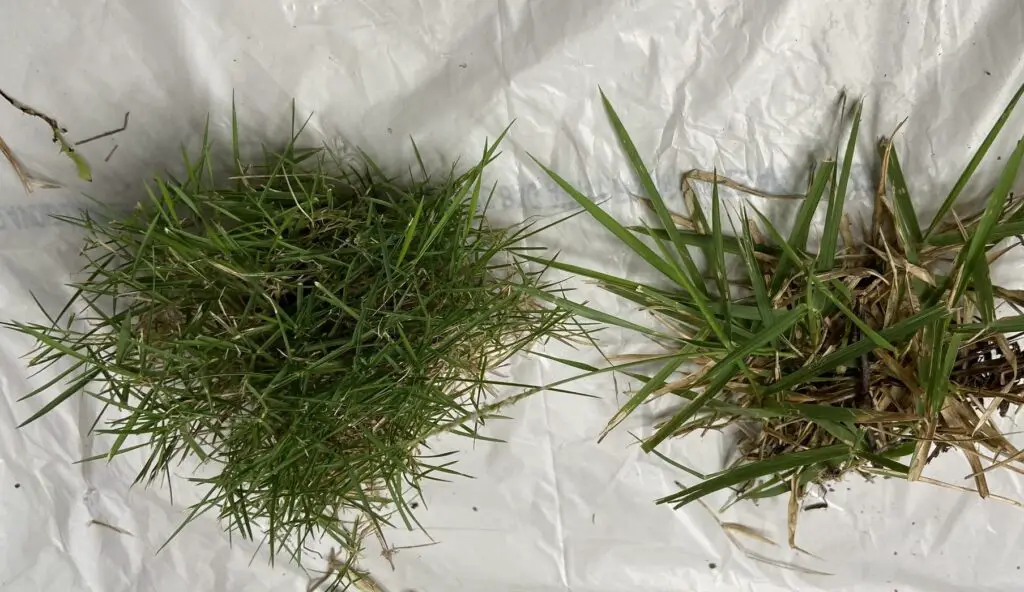
Two turfgrass varieties often compared are Bermuda grass and Zoysia grass.
While both are warm-season grasses that thrive in similar growing environments, there are areas that they differ.
Zoysia Japonica is a medium bladed zoysia grass and Matrella has a grass leaf blade similar to hybrid Bermudas.
Two of the biggest differences between the two are shade tolerance and hardiness.
Bermuda grass is fast-growing with a high tolerance to heat, droughts, and foot traffic.
Its leaf blades are thin, narrow, with sharp-pointed tips that give it a flat appearance.
Bermuda grass grows and recovers from stress quickly, and its ability to withstand foot traffic makes it ideal for large open areas as well as sports fields.
On the other hand, Zoysia grass offers a thicker, softer feel underfoot due to its dense growth habit and texture.
When you walk on zoysia you actually feel like you’re walking on carpet.
Zoysia offers higher tolerance to shade and cool climatic conditions compared to Bermuda.
It maintains an even green hue most of the year and tolerates frosty winter conditions due to its deep root system.
Bermuda grass vs Zoysia grass comparison chart:
| Bermuda Grass | Zoysia Grass | |
|---|---|---|
| Appearance | Exhibits medium to dark green color, fine texture and a more manicured appearance | Exhibits deep green color, a dense, fine texture, with a soft carpet-like feel |
| Leaf Blade Width | 1-5 mm | 2-4 mm |
| Height | 1-3 inches | 1-2 inches |
| Max Height | 2-3 inches | 2-3 inches |
| Growth Pattern | Grows aggressively and quickly | Grows slowly and less aggressively |
| Sun/Shade Tolerance | Good tolerance for full sun, but less tolerant of shade | Excellent shade tolerance but less tolerant of full sun |
| Cold Tolerance | Poor cold tolerance, turns brown during winter in colder regions. Does not like extremely cold regions. | Good cold tolerance, can withstand colder temperatures without turning brown, but will turn brown in freezing temperatures. |
| Drought Tolerance | Good drought tolerance, can handle dry conditions better than most grasses | Excellent drought tolerance, can survive long periods of dry weather without water |
| Maintenance Needs | High maintenance needs, requiring frequent mowing, watering and fertilizing | Low maintenance needs, requiring less frequent mowing, watering and fertilizing |
Bermuda grass vs Zoysia grass advantages and disadvantages
| Bermuda Grass | Zoysia Grass | |
|---|---|---|
| Advantages | Fast-growing with high tolerance to heat, droughts, foot traffic. | Soft underfoot due to its lush texture with minimal thatch buildup. Maintains an even color throughout the year in hot climates. Tolerates shade and frosty winter conditions better than Bermuda grass. |
| Disadvantages | Loses vibrancy in fall months compared to Zoysia grass. Can require frequent mowing during peak growing periods. Can become invasive if not properly maintained. | Requires more maintenance than some species like Centipede grass. Slower growth rate compared to Bermuda grass. Not as tolerant of heavy foot traffic as Bermuda grass. |
It is important to factor in shade-tolerance needs into the decision-making process when considering premium warm-season turfgrasses.
Bermuda Grass requires lots of maintenance input during peak growing periods annual plant fertilizing and chemical treatment to keep it looking its best and to help control disease and insect invasion.
Bermuda vs St Augustine grass
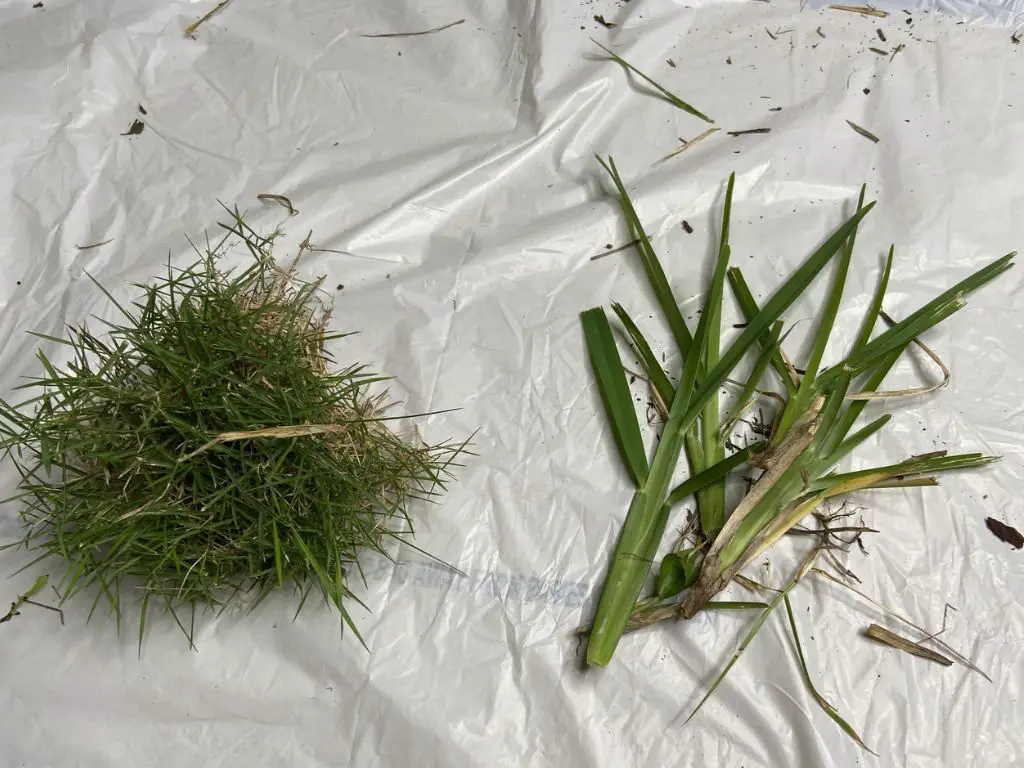
How Can You Tell Bermuda Grass From St. Augustine?
Bermuda and St. Augustine are two of the more popular options when considering warm-season turfgrasses.
Both grasses look good when maintained and can hold their own in high temperatures, but there are important differences between the two.
Bermuda Grass is a thin blade fast-growing sod characterized by its rhizomes’ low to the ground growth pattern.
Along with heat tolerance and drought resistance features, it thrives in full sun exposure and delivers excellent performance in high usage areas.
St. Augustine Grass has a wide thick leaf blade with dense foliage.
It has a coarse thick feel underfoot while providing a thick lush lawn; weed control while maintaining color and vigor throughout summer months.
St Augustine has the advantage of good shade tolerance; making it genuinely a go-to for shady lawns.
The downside to St.Augustine’s is its susceptibility to chinch bugs and various fungal infections than common than Bermuda.
Overall, both grass varieties have advantages and disadvantages as far as durability, disease resistance, maintenance needs.
Bermuda vs St Augustine grass comparison chart:
| Characteristic | Bermuda Grass | St. Augustine Grass |
|---|---|---|
| Appearance | Dark green color, fine texture and a more manicured appearance | Broad, flat blades with a blue-green color and a coarser texture |
| Leaf blade width | 1-3mm | 4-10mm |
| Height | 1-3 inches | 2-4 inches |
| Max height | 2-3 inches | 5-6 inches |
| Growth Pattern | Growsaggressively and quickly | Grows slowly |
| Sun/Shade Tolerance | Good tolerance for full sun, but less tolerant of shade | Good shade tolerance, but less tolerant of full sun |
| Cold Tolerance | Poor cold tolerance, turns brown during winter in colder regions | Good cold tolerance, can withstand colder temperatures without turning brown |
| Drought Tolerance | Good drought tolerance, can handle dry conditions better than most grasses | Moderate drought tolerance, can wilt and turn brown during extended dry periods |
| Maintenance Needs | High maintenance needs, requiring frequent mowing, watering and fertilizing | Moderate maintenance needs, requiring less frequent mowing, watering and fertilizing |
Bermuda grass vs St Augustine grass advantages and disadvantages
| Bermuda Grass | St. Augustine Grass | |
|---|---|---|
| Advantages | Rapid growth rate with the ability to recover quickly from damage. | Prefers partial shade over full sunlight exposure. |
| Excellent drought resistance capacities compared to St. Augustine grass. | They provide thick turfgrass coverage preventing weed breakouts. | |
| Can survive on just 6 hours of sunlight per day making it a suitable choice for partially shady lawns. | Easier to manage and do not require frequent pruning. | |
| Disadvantages | Requires regular mowing during growing seasons; can become a full-on weed invasion. | Prone to thatch buildup making it challenging to aerate lawns. |
| Can be invasive and outcompete surrounding plants if not checked regularly. | Inadequate drought tolerance often requiring more watering. | |
| Recommended only for high traffic urban areas resulting in more maintenance needs. | Requires maximum sun exposure during growth seasons. |
Bermuda vs Centipede Grass

Bermuda and Centipede are two commonly use turf options with similar and distinct characteristics.
While Bermuda grass grows fast and has excellent drought resistance, Centipede grass offers a low-maintenance option that is ideal for those seeking a turfgrass that is to care for.
Bermuda vs Centipede.
Whether you opt for the quick-growing Bermuda or the low-maintenance Centipede, both varieties offer advantages and disadvantages that should be carefully considered before making a final decision.
Bermuda grass boasts a rapid growth rate that allows it to quickly establish itself as a lush green carpet.
Its excellent drought resistance means it requires less water than other types of grass, making it ideal for those living in hot and dry climates.
On the other hand, Centipede grass offers a low-maintenance option that requires minimal fertilization and maintenance, making it an affordable choice for those who prefer a hands-off approach to lawn care. \
If you’re looking for a fast-growing turfgrass that can withstand heavy foot traffic and requires less water than other types of grasses, then Bermuda may be the right choice for you.
However, if you prefer a low-maintenance option that can thrive in poor soil conditions and doesn’t require frequent mowing or fertilization, then Centipede may be the better option.
Bermuda vs Centipede comparison chart:
| Characteristics | Bermuda Grass | Centipede Grass |
|---|---|---|
| Appearance | Dark green color, fine texture | Coarse texture, light green color |
| Leaf blade width | 1-3 mm | 2-4 mm |
| Height | 0.5-1.5 inches | 1.5-3 inches |
| Max height | 1.5-2 inches | 3-4 inches |
| Growth Pattern | Spreads aggressively and quickly | Spreads slowly and less aggressive |
| Sun/Shade Tolerance | Good tolerance for full sun, but less tolerant of shade | Good shade tolerance, but less tolerant of full sun |
| Cold Tolerance | Poor cold tolerance, turns brown during winter in colder regions | Excellent cold tolerance, can handle colder temperatures without turning brown |
| Drought Tolerance | Good drought tolerance, can handle dry conditions better than most grasses | Excellent drought tolerance, can survive long periods of dry weather without water |
| Maintenance Needs | High maintenance needs, requiring frequent mowing, watering and fertilizing | Low maintenance needs, requiring less frequent mowing, watering and fertilizing |
Bermuda grass vs Centipede grass advantages and disadvantages
| Bermuda Grass | Centipede Grass | |
|---|---|---|
| Advantages | – Rapid growth rate that quickly establishes a dense lawn – Excellent drought resistance, requiring less watering than other types of grass – High tolerance for foot traffic, making it ideal for high-traffic areas like sports fields and playgrounds |
– Low-maintenance option that requires minimal fertilization and mowing compared to other warm-season grasses – Well-suited for poor soil conditions due to its shallow root system – Relatively low water requirement compared to other turfgrass varieties |
| Disadvantages | – Requires frequent mowing during peak growing periods – Can become invasive if not properly maintained< – Susceptible to disease and insect infestations if proper care is not taken |
– Limited shade tolerance, requiring almost full sunlight exposure – Shallow root system makes it more susceptible to drought and heat stress – Not as tolerant of foot traffic as Bermuda grass, making it less suitable for high-traffic areas like sports fields or playgrounds. |
Weigh the advantages and disadvantages of each type of grass as well as your intended usage needs before making a final decision.
Bermuda vs Bahia Grass
Two popular choices of grass for your lawn, include Bermuda and Bahia.
Each s that must be considered before making your final choice.
Bermuda grass is well known for its resilience and good looks, making it ideal for households with active children and pets.
Unfortunately, however, regular maintenance such as watering and fertilization is required which can prove time consuming and costly over time.
Bahia grass requires minimal care to thrive in hot weather and provides exceptional drought resistance, though its growth rate may take longer to establish lush lawns than Bermuda grass does.
| Bermuda Grass | Bahia Grass | |
|---|---|---|
| Advantages | 1. Durable: Bermuda grass is known for being strong enough to withstand even heavy foot traffic, providing ample durability benefits. 2. High Quality Appearance: With its superior look and vibrant hue, Bermuda grass makes a striking statement when placed in any garden or lawn space. 3. Fast Growing: Bermuda grass grows quickly, making it ideal for creating an instantaneous lawn quickly. 4. Easy Planting: Planting Bermuda grass seeds requires only minimal care to get them growing within 10 days! |
1. Low Maintenance Needs: Bahia is low-maintenance grass that only needs occasional cutting during its growing season. 2. Drought Tolerant Grass: Bahia grass can withstand drought conditions well and thus make an ideal option in areas that receive lower rainfall or face water scarcity issues. 3. Bahia grass can repel several common pests such as chinch bugs and root knot nematodes, making it an attractive option for homeowners wanting low maintenance lawns without breaking their budgets. 4. It Is Affordable |
| Disadvantages | 1. High Maintenance: To keep Bermuda grass looking its best and maintaining quality and aesthetic appeal requires regular watering, fertilizing and mowing. 2. Invasive: If unmanaged properly it could quickly take over other plants in your garden or landscape and expand rapidly outward. 3. Prone to Diseases: Bermuda grass can be susceptible to diseases when poorly watered and fertilized, particularly with incorrect maintenance techniques such as improper watering and fertilizing regimens. |
1. Slow Growing Rate: Bahia grass has a slower growth rate compared to Bermuda grass and therefore may take longer to establish a lush lawn. 2. Seed Availability: Unfortunately, there is limited supply of Bahia grass seeds relative to other forms of turfgrass seeds. 3. Appearance: Bahia grass may not appear to be as visually appealing during winter months compared to some other turfgrasses such as Bermuda grass, though its color remains appealing and distinctive. |
Bermuda vs Kentucky Bluegrass
Bermuda grass is known for its durability and ability to withstand heavy foot traffic, making it ideal for families with active kids and pets.
However, Kentucky Bluegrass has a more appealing aesthetic look and feels much softer underfoot like walking on carpets due to its fine texture.
What will likely determine whether you choose one over the other is the conditions at your property.
Bermuda needs full sun and warm temperatures to thrive, while Kentucky Bluegrass thrives in sun and shady areas.
Bluegrass is also know as a cool-season grass which tolerates cold climates.
While Bermuda grass requires high maintenance with regular watering, fertilizing, and mowing requirements,
Kentucky bluegrass is less demanding once established.
But in the end, whether its Bermuda or Bluegrass, both can transform any backyard into a beautiful oasis!
Bermuda vs Kentucky Bluegrass Comparison Chart:
| Characteristics | Bermuda Grass | Kentucky Bluegrass |
|---|---|---|
| Appearance | Dark green color, fine texture and a more manicured appearance | Bright green color, fine texture, soft and carpet-like feel |
| Growth Pattern | Spreads aggressively and quickly | Spreads slowly and less aggressively |
| Sun/Shade Tolerance | Good tolerance for full sun, but less tolerant of shade | Good tolerance for shade, but less tolerant of full sun |
| Cold Tolerance | Poor cold tolerance, turns brown during winter months in colder regions | Good cold tolerance, can withstand colder temperatures without turning brown |
| Drought Tolerance | Good drought tolerance, can handle dry conditions better than most grasses | Moderate drought tolerance, may require irrigation during extended periods of dry weather |
| Maintenance Needs | High maintenance needs, requiring frequent mowing, watering and fertilizing | Moderate maintenance needs, requiring regular mowing, watering, and fertilizing |
| Bermuda Grass | Kentucky Bluegrass | |
|---|---|---|
| Advantages | 1. Durable | 1. Aesthetic appeal |
| 2. Easy to grow | 2. Softness underfoot | |
| 3. High-quality appearance | 3. Tolerance for low temperatures | |
| 4. Tolerance to high temperatures | 4. Versatile | |
| Disadvantages | 1. High maintenance | 1. High water requirement |
| 2. Invasive nature | 2. Slow establishment | |
| 3. Prone to diseases | 3. High maintenance cost |
Choosing between Bermuda grass and Kentucky Bluegrass depends on your specific needs and location.
Kentucky Bluegrass cannot tolerate too much heat and is used in cooler climates; and Bermuda cannot tolerate extreme cold and is used in warmer climates.
Both types can transform any backyard into a perfect oasis!
Bermuda vs Fescue grass
Are you torn between selecting Bermuda or Fescue grass for your lawn?
Bermuda grass is known for its resiliency during summers and heavy foot traffic area; while Fescue grass is a cool-season grass that is perfect for cooler climates with regular rainfall or watering schedules.
Bermuda grass grows quickly but requires high maintenance care, while fescue has a slower growth rate and can survive with less watering, but it may not provide as much durability when facing extreme weather conditions.
Selecting which one is right for you depends on understanding their advantages and disadvantages – so let’s examine the pros and cons!
Bermuda vs Fescue grass comparison chart:
| Bermuda Grass | Fescue Grass | |
|---|---|---|
| Advantages | 1. Durable: Can withstand heavy foot traffic. | 1. Cold Tolerance: Adapts well in colder environments. |
| 2. High-Quality appearance: Provides an attractive and uniform look. | 2. Shade Tolerance: Tolerates shaded areas well. | |
| 3. Tolerance to high temperatures: Thrives in hot weather conditions. | 3. Requires less maintenance: Slower growth rate. | |
| 4. Fast-growing: Establishes quickly, perfect for establishing new lawn. | 4. Drought-resistant: Can survive dry weather conditions. | |
| Disadvantages | 1. High maintenance: Needs regular watering, fertilizing, and mowing. | 1. Foot Traffic Tolerance: Not as durable as Bermuda grass. |
| 2. Invasive nature: Can take over other plants in garden or landscape. | 2. Growth Rate: Slow growth rate may require patience. | |
| 3. Prone to diseases: Requires proper care to avoid lawn diseases. | 3. Prone to fungal diseases: Vulnerable to brown patch disease. |
Both Bermuda and fescue grasses have unique features that make them ideal for specific environments or lawn care routines.
While Bermuda offers durability in high traffic areas capable of tolerating hot weather conditions but requiring much high maintenance.
On the other hand, fescue provides an attractive visual appeal with low-maintenance care ideal for cooler climates, including shaded areas, with drought resistance but lacking durability in high traffic areas.
How Can You Tell Crabgrass From Bermuda?

The easiest way to tell the difference between crabgrass and bermuda is to look at the grass leaf blade width.
Bermuda is narrow leafed and low growing.
Crabgrass has a wide leaf blade and grows taller.
While the most obvious difference between the two grass is their leaf blade width and growth habit, there are other physical characteristics that can help you identify them.
Bermuda grass has a fine texture with narrow leaf blades that grow close to the ground.
Its leaves are typically flat, slender, and pointed with small hairs on both sides of the blade.
Bermuda grass roots deeply into soil up to 8 feet deep making it highly drought-resistant.
The growth pattern of this warm-season perennial grass involves both above-ground horizontal runners called stolons which expand outwards creeping through the soil producing new shoots while beneath ground rhizomes further establish roots.
Crabgrass, on the other hand, is an annual weed that sprouts from seed during summer months only surviving for one growing season before dying in frosty conditions later in fall.
This nuisance is characterized by wide leaf blades with slightly hairy surfaces, and long seed heads extending above the leaf blades once matured.
Crab grass grows uprightly forming clumps rather than producing runners or rhizomes around its base like bermuda which means it’s easily identifiable amongst turfgrasses.
Another way to distinguish between these two types of grasses is by their growth habits.
Bermuda grass grows low with a dense mat-like appearance throughout your lawn.
The leaves of Bermuda grass can grow up to 6 inches in length, but they generally grow much shorter, between 1 and 2 inches.
It typically grows well in full sun exposure areas and is resistant to droughts and warm temperatures.
Unlike Bermuda that spreads outwards, Crabgrass tends to grow vertically producing seed heads reaching above its foliage when matured.
This makes it easy to spot amongst other turfgrasses.
Crabby also requires a lot of shade during the earlier stages of growth making it easier for it to invade shaded sections within your lawn.
It prefers warm weather conditions, high moisture levels, and soil disturbance which make it invasive if left untreated over time.
Bermuda vs Crabgrass Identification Chart:
| Bermuda Grass | Crabgrass | |
|---|---|---|
| Physical Characteristics | Fine texture with narrow leaf blades. Leaves grow close to the ground. Flat, slender, and pointed leaves with small hairs on both sides of the blade. Can root deeply into soil up to 8 feet deep. |
Wide leaf blades with slightly hairy surfaces. Long seed heads extend above the leaf blades once matured. Grows uprightly forming clumps. |
| Growth Habits | Low growing with a dense mat-like appearance. Leaves can grow up to 6 inches in length but generally between 1 and 2 inches. Spreads through both above-ground horizontal runners called stolons and underground rhizomes. Grows well in full sun exposure areas and is resistant to drought and warm temperatures. |
Grows vertically producing seed heads that reach above its foliage when matured. Tends to grow in clumps and prefers warm weather conditions, high moisture levels, and soil disturbance. Requires a lot of shade during the earlier stages of growth. |
| Identifying Characteristics | Narrow leaf blade width. Low growing. Dense mat-like appearance. Spreads through runners and rhizomes. Highly drought-resistant. | Wide leaf blade width. Taller growing. Uprightly growing. Forms clumps. Requires shade during earlier growth stages. |
| Advantages | Highly drought-resistant. Resistant to warm temperatures. Forms a dense mat-like appearance. |
None (considered invasive). |
| Disadvantages | Can be invasive and difficult to control. Can be damaged by colder temperatures. Grows slowly. |
Considered an invasive weed. Prefers shaded areas. Can easily invade your lawn if left untreated over time. |
Knowing these traits will help you distinguish between them quickly and efficiently when needed so that you can take appropriate actions necessary in cases where unwanted weed strands are present in your lawn while also maintaining a healthy-looking yard throughout the year.
Does bermuda grass look like crabgrass?
No, bermuda grass does not look like crabgrass. Bermudagrass has thin narrow leaf blades and crabgrass has wide broad leaf blades.
Does bermuda grass spread?
Yes, bermuda is known for spreading and is considered an invasive weed in many locations.
What does bermuda grass look like in winter?
Bermuda grass turns brown as temperatures drop, as it does go dormant during winter and cold weather.
As temperatures begin to drop during the winter months, Bermuda grass undergoes some noticeable changes.
There are multiple key traits of Bermuda grass during winter, making it easy to identify.
Color Transformation:
One of the most obvious changes in Bermuda grass during winter is its shift in color. As temperatures drop, it transitions from its vibrant green hue to a brown or tan shade. This color change signifies that the grass has entered dormancy, a natural survival mechanism to withstand colder temperatures.
Dormancy:
Bermuda grass goes dormant during the winter months, especially when temperatures consistently fall below 50°F (10°C). During this period, the grass ceases to grow and focuses its energy on preserving its root system. As a result, the turf may appear thin and less dense compared to its lush, green summer appearance.
Leaf Blades:
Although Bermuda grass maintains its signature narrow, thin leaf blades in winter, they may appear less prominent. The blades may flatten and become less rigid, contributing to the overall thinner appearance of the turf.
Root System:
While the above-ground portion of Bermuda grass may appear lifeless during winter dormancy, its root system remains active beneath the soil. This allows the grass to store nutrients and energy, which will help it bounce back once warmer temperatures return.
Weed Susceptibility:
Dormant Bermuda grass can be more susceptible to weed invasion during winter due to its thinner turf coverage. It is essential to monitor your lawn for weeds and address them promptly to prevent them from becoming established.
What does dormant bermuda grass look like?
Dormant Bermuda grass has a distinct look compared to its lively appearance during the growing season.
As a warm-season grass, Bermuda grass enters a state of dormancy during the winter months, where it conserves its energy and reduces its growth rate.
Despite being dormant, Bermuda grass still retains some of its key traits that make it easily identifiable.
When it’s dormnant the color is usually light brown to golden brown color.
What Does Bermuda Grass Look like? Bermuda Grass Identification
It’s thin leaf low growing with a smooth appearance throughout your lawn.
How to make bermuda grass thicker

